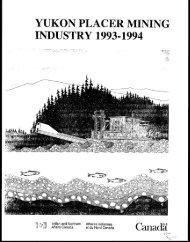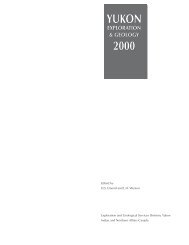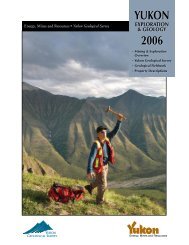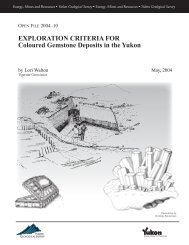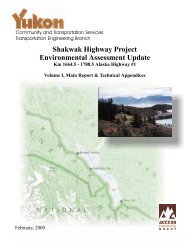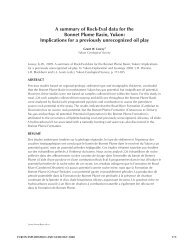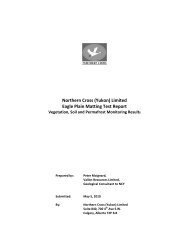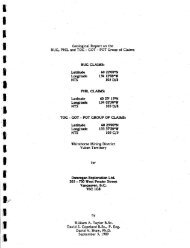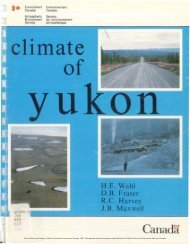WhiteCAP_Plan_01SEPT..
WhiteCAP_Plan_01SEPT..
WhiteCAP_Plan_01SEPT..
You also want an ePaper? Increase the reach of your titles
YUMPU automatically turns print PDFs into web optimized ePapers that Google loves.
Northern Climate ExChange <strong>WhiteCAP</strong> Draft <strong>Plan</strong><br />
4.0 Climate and Whitehorse<br />
The city of Whitehorse is located in the Upper Yukon-Stikine Basin climate region of<br />
Yukon (Whal et al, 1987). This climate region is influenced by the St Elias/Coast<br />
Mountain Ranges, which create a rain shadow. This rain shadow influences the amount<br />
of precipitation that falls in the region, typically 200 to 325mm per annum (Yukon<br />
Ecoregions Working Group, 2004). Mean annual temperature for the region is -1°C to -<br />
2°C (Yukon Ecoregions Working Group, 2004). The northwest-southeast orientation of<br />
the valley in which Whitehorse has been developed ensures the city is the most<br />
consistently windy location in the region (Whal et al, 1987).<br />
This section summarizes the climate of Whitehorse. Past trends in precipitation and<br />
temperature are provided. As well, climate projections through to the 2050’s are<br />
provided. Trends and projections are compared to climate normal from 1961-1990.<br />
Projected climate changes to the Whitehorse area were generated by the Scenarios<br />
Network for Alaska <strong>Plan</strong>ning (SNAP). SNAP is located at the University of Alaska-<br />
Fairbanks. The trend analysis was completed by NCE over the winter of 2010.<br />
4.1 Past Climate Trends in the Whitehorse Area<br />
Climate has been changing in Whitehorse. It is clear from meteorological data going<br />
back to the 1940’s that temperature has been warming, especially in winters. Winter also<br />
has the greatest variability in temperature. Break up has been arriving earlier, freeze up<br />
later and growing degree days have been increasing. Past climate trends give us a<br />
context from which to evaluate local climate and also a sense whether or not the climate<br />
has been changing. Trends can be compared against projections of future climate, such<br />
as those provided in the next section. Where the trend agrees with projections, our<br />
confidence in knowing the future climate increases. Where the trends disagree with<br />
projections, our confidence decreases.<br />
Whitehorse is semi-arid. While there has been a small increase in precipitation over<br />
recent decades, there is already a great deal of variability in precipitation and therefore,<br />
the trend is difficult to discern. Further, some data from recent decades has been lost.<br />
Non-parametric trend analysis (thus avoiding biases associated with missing data) show<br />
that winter precipitation is trending down. The trends for temperature and precipitation<br />
are provided in Table 4.1.<br />
Flow data is available for the Yukon River at Whitehorse. Warming trends and the<br />
melting of the glaciers which feed the Upper Yukon Basin have increased lake levels in<br />
the system above Whitehorse but have not resulted in appreciable increase in overall<br />
annual flow of the Yukon River through Whitehorse. Seasonal variation in flow has<br />
changed, but this is most likely to be as a result of hydrological control systems operated<br />
by Yukon Energy and not a change in the climate system. Flooding is not typically<br />
associated with peak flow in summer, but is instead related to both freeze up (and ice<br />
damming) and spring melt (especially in heavy snow years with rapid melt onset).<br />
Standard meteorological data show a decreasing trend for wind at Whitehorse. However,<br />
more detailed research using weather balloons show a clear increase in wind. This<br />
contradiction is likely explained by changes to the horizon as trees have grown up or<br />
been replaced by buildings. Both trees and buildings will break the wind and affect<br />
14



